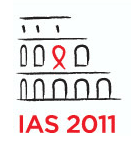 Genital secretions from women living with HIV using antiretroviral (ARV) therapy contain high drug concentrations and low amounts of infectious virus, according to an important new study conducted by Anandi Sheth, MD, and her colleagues at the Emory Center for AIDS Research in Atlanta. The results were shared Monday, July 18, at the 6th IAS Conference on HIV Pathogenesis, Treatment and Prevention in Rome.
Genital secretions from women living with HIV using antiretroviral (ARV) therapy contain high drug concentrations and low amounts of infectious virus, according to an important new study conducted by Anandi Sheth, MD, and her colleagues at the Emory Center for AIDS Research in Atlanta. The results were shared Monday, July 18, at the 6th IAS Conference on HIV Pathogenesis, Treatment and Prevention in Rome.
It is well known that higher concentrations of HIV in genital secretions among women are linked to a greater risk of transmitting the virus to sexual partners, notably in countries where heterosexual sex remains a major risk factor for infection. And while ARVs are known to suppress HIV in the blood and are believed to penetrate the female reproductive tract, studies have documented that HIV can persist in genital secretions, with levels fluctuating during the menstrual cycle.
Research exploring the effects of compounds that target HIV on the female genital tract is essential, given the heightened interest in vaginal microbicides, pre-exposure prophylaxis and treatment as prevention. Determining which approach is most effective in terms of delivering drugs to tissues that are most at risk for HIV or shedding the virus is important.
According to Sheth—whose work reported here qualified her to be the sole recipient of the IAS 2011 Young Investigator Award in prevention science—some ARVs penetrate the female genital tract better than others.
ARVs believed to achieve higher concentrations in the female genital tract than in the blood are: Epivir (lamivudine), Emtriva (emtricitabine), Retrovir (zidovudine), Intelence (etravirine), Crixivan (indinavir), Prezista (darunavir), Selzenty (maraviroc) and Isentress (raltegravir). ARVs less likely to concentrate in the female genital tract, compared with the blood, are: Videx EC (didanosine), Ziagen (abacavir), Zerit (stavudine), Rescriptor (delavirdine), Sustiva (efavirenz), Lexiva (Amprenavir), Norvir (ritonavir), Reyataz (atazanavir), Kaletra (lopinavir) and Invirase (saquinavir). The drugs Viread (tenofovir) and Viramune (nevirapine) have comparable concentrations in blood and the female genital tract.
Sheth and her colleagues set out to characterize female genital tract drug concentrations and HIV shedding over one menstrual cycle among women using a common ARV regimen: Norvir-boosted Reyataz combined with Truvada.
Six pairings of blood and female genital tract samples were collected from 20 women, with two samples collected during the follicular phase (following menstruation but before ovulation) and four collected during the luteal phase (the first day of ovulation through the remainder of the cycle).
The average age of the women was 36, and roughly 95 percent were black. The volunteers knew they were living with HIV for an average of nine years, and most had been on some form of ARV therapy for 90 months and had been on the study regimen for an average of 14 months.
HIV concentrations—both free virus (HIV RNA) and virus already in cells (HIV DNA)—were generally lower in genital secretions than in blood samples, though the assays used in the tests defined “undetectable” differently: Less than 50 for blood and less than 500 for genital secretions. However, even when the result was undetectable, these assays were still able to detect the low-level presence of virus.
HIV RNA was detected in blood samples in 69 of the 120 samples in 16 women (80 percent), whereas HIV RNA was in genital secretion samples in only 19 of 120 samples in 9 women (45 percent). Moreover, 11 of the 120 blood samples, involving 40 percent of the women, had detectable viral loads, whereas there was no detectable virus in any of the genital secretion samples collected from any of the women.
HIV RNA in the blood was more likely to be detectable during the follicular phase and lowest during the beginning of the luteal phase, whereas HIV RNA in the genital tract was more likely to be detected immediately following menstruation and at the beginning of the luteal phase. However, the variability of detectable HIV in genital secretions was not statistically significant, meaning that it could have been due to chance.
The factors shown to be potentially associated with HIV in the genital tract were white blood cells and blood being present in genital secretions.
Interestingly, all active drugs used in the regimen achieved higher concentrations in the female genital tract than in the blood. This finding runs counter to research exploring drug concentrations in the female genital tract, particularly the observation that Reyataz levels in genital secretions exceeded those found in the blood. What’s more, drug levels were consistently higher throughout the menstrual cycles of the 20 women.
In conclusion, Sheth noted that ARV treatment resulted in adequate female genital tract penetration of all drugs throughout the menstrual cycle. While levels of the emtricitabine and tenofovir in Truvada are similar to those reported previously, the higher levels of Reyataz came as a pleasant surprise.
In the presence of antiretroviral therapy, Sheth reiterated that her group was unable to detect HIV RNA at a quantifiable amount in the female genital tract. And while this is encouraging news, she warned that “detection of low-level genital HIV RNA suggests local viral replication that is not completely inhibited.” She added: “The presence of low-level female genital tract HIV RNA and proviral DNA suggests ARV treatment reduces, but may not completely eliminate, sexual transmission.”






Comments
Comments